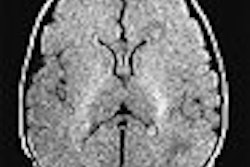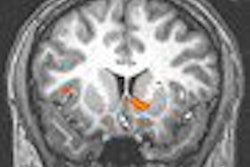Diffusion tensor imaging (DTI) can bolster brain MR when zeroing in on seizure sites in temporal lobe epilepsy (TLE), according to a presentation Tuesday at the American Society of Neuroradiology (ASNR) meeting in Seattle. This information could then aid in pre-surgical planning, said the authors from Drexel University in Philadelphia and the University of Illinois in Peoria.
"Patients who have seizures, who are not being adequately treated with medicine, are ... surgical candidates," said lead author Dr. Scott Faro in a phone interview with AuntMinnie.com from the ASNR meeting. "Sometimes, (clinicians) are not sure which temporal lobe is causing the abnormality. You'd like to have a clinically positive EEG that's on one side that correlates to an imaging finding. Traditionally that was with MRI." Faro is a professor and vice-chairman of radiology at Drexel, and director of the MRI Research Laboratory.
Faro and colleagues performed diffusion tensor imaging and high-resolution brain MR on 23 TLE patients. Diffusion-weighted images were collected along six different directions (b = 10000 sec/mm2). One image was acquired without diffusion-weighting b = 0 sec/mm2).
"We obtained the diffusivity and fractional anisotrophy (FA) values from symmetrical voxels sampling the head of the hippocampus bilaterally," they wrote in their abstract. "We determined abnormal DTI measurements by comparing hippocampal diffusivity and FA values to those of normal subjects."
Patients underwent 30 minutes of imaging on a 1.5-tesla scanner (Siemens Medical Solutions, Malvern, PA) with 17 coronal slices covering the temporal lobes acquired (3 mm thickness). The imaging parameters included:
- TR = 6000 ms
- TE = 100 ms
- FOV = 240, 98 x 128
- 4 acquisitions
T2-weighted inversion recovery images also were obtained in the same locations (TR = 5500 ms, TE = 90 ms, FOV = 240 mm, 260 x 512, T1 = 150 ms, 1 acquisition). Diffusion tensor imaging and MR images were correlated with the epileptogenic temporal lobe as determined by clinical localization.
According to the results, diffusion tensor imaging was abnormal in 17 of 23 patients, for a sensitivity of 78%. It also accurately lateralized the epileptogenic region in all 17 cases. The MR scans also indicated abnormalities in 17 of 23 patients for a sensitivity of 78%. Three patients with negative MR had abnormal diffusion tensor imaging measurements, the group reported.
Faro added that separately, DTI or MRI found abnormalities in 20 of 23 patients. However, the goal with this study was not to pit the two against each other or replace MRI with DTI. Instead, "this test is not an isolated test, but could be an additive test to increase our sensitivity and confidence level," Faro said.
However, pairing DTI with MRI does offer advantages over other modalities that have been promoted for pre-op seizure localization, including PET and SPECT.
"SPECT is very challenging in the temporal lobe because of the artifacts related to the bone-cranial interface," Faro noted. "So spectroscopy has not been that helpful. PET is used but it does have false-negatives. It also has an expense factor."
The next stage of research for Faro's group will be interpreting the diffusion tensor data with 2D color flow. "The preliminary data is very positive to show the abnormal diffusion and directional changes of white matter," Faro said. "We're going to follow that with 3D tractology to define the full extent of the white matter to disease throughout the entire hippocampus."
By Shalmali PalAuntMinnie.com staff writer
June 9, 2004
Related Reading
Neuroimaging recommended in assessment of children with cerebral palsy, March 23, 2004
PET, SPECT guide pre-op seizure localization in epilepsy, June 22, 2003
The truth is out there: fMRI uncovers human deception, June 11, 2003
Copyright © 2004 AuntMinnie.com



















